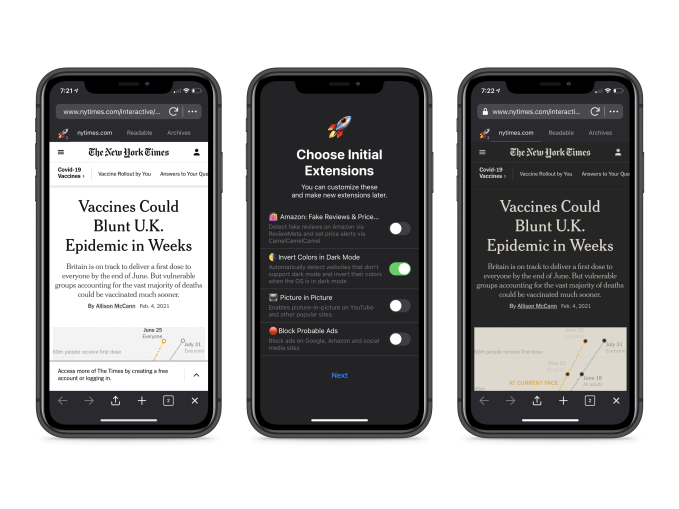Welcome back to The TechCrunch Exchange, a weekly startups-and-markets newsletter. It’s broadly based on the daily column that appears on Extra Crunch, but free, and made for your weekend reading. Want it in your inbox every Saturday morning? Sign up here.
Ready? Let’s talk money, startups and spicy IPO rumors.
Earlier this week TechCrunch broke the news that Public, a consumer stock trading service, was in the process of raising more money. Business Insider quickly filled in details surrounding the round, that it could be around $200 million at a valuation of $1.2 billion. Tiger could lead.
Public wants to be the anti-Robinhood. With a focus on social, and a recent move away from generating payment for order flow (PFOF) revenues that have driven Robinhood’s business model, and attracted criticism, Public has laid its bets. And investors, in the wake of its rival’s troubles, are ready to make it a unicorn.
Of course, the Public round comes on the heels of Robinhood’s epic $3.4 billion raise, a deal that was shocking for both its scale and speed. The trading service’s investors came in force to ensure it had the capital it needed to continue supporting consumer trades. Thanks to Robinhood’s strong Q4 2020 results, and implied growth in Q1 2021, the boosted investment made sense.
As does the Public money, provided that 1) The company is seeing lots of user growth, and 2) That it figures out its forever business model in time. We cannot comment on the second, but we can say a bit about the first point.
Thanks not to Public, really, but M1 Finance, a Midwest-based consumer fintech that has a stock-buying function amongst its other services (more on it here). It told TechCrunch that it saw a quadrupling of signups in January as compared to December. And in the last two weeks, it saw six times as many signups as the preceding two weeks.
Given that M1 doesn’t allow for trading — something that its team repeatedly stressed in notes to TechCrunch — we can’t draw a perfect line between M1 and Public and Robinhood, but we can infer that there is huge consumer interest in investing of late. Which helps explain why Public, which is hunting up a way to generate long-term incomes, can raise another round just months after it closed a different investment.
Our notes last year on how savings and investing were the new thing last year are accidentally becoming even more true than we expected.
Market Notes
As the week came to a close, Coupang filed to go public. You can read our first look here, but it’s going to be big news. Also on the IPO beat, Matterport is going out via a SPAC, I chatted with Metromile CEO Dan Preston about his insurtech public offering this week that also came via a SPAC, and so on.
Oscar Health filed, and it doesn’t look super strong. So its impending valuation is going to test public traders. That’s not a problem that Bumble had when it priced above-range this week and then skyrocketed after it started to trade. Natasha and I (she’s on Equity, as well) have some notes from Bumble CEO Whitney Wolfe Herd that we’ll get to you early next week. (Also I chatted about the IPO with the BBC a few times, which was neat, the first of which you can check out here if you’d like.)
Roblox’s impending public debut was also back in the news this week. The company was a bit bigger than it thought last year (cool), but may delay its direct listing to March (not cool).
Near to the IPO beat, Carta started to allow its own shares to trade recently, on the back of news that its revenues have scaled to around $150 million. Not bad Carta, but how about a real IPO instead of staying private? The company’s valuation more than doubled during the secondary transitions.
And then there were so very many cool venture capital rounds that I couldn’t get to this week. This Koa Health round, for example. And whatever this Slync.io news is. (If you want some earlier-stage stuff, check out recent rounds from Treinta, Level, Ramp and Monte Carlo.
And to close, a small callout to Ontic, which provides “protective intelligence software” and said that its revenue grew 177% last year. I appreciate the sharing of the numbers, so wanted to highlight the figure.
Various and Sundry
Wrapping this week, I have a final bit for you to chew on from Mark Mader, the CEO of Smartsheet, a public company — former startup, it’s worth noting — that plays in the no-code, automation and collaboration markets. That’s a rough summary. Anyhoo, I asked Mader about no-code trends in 2021, as I have my eyes on the space. Here’s what he wrote for us:
If you thought the sudden shift to remote work sped up corporate America’s shift to digital, you haven’t seen anything yet. Digital transformation is going to accelerate even more rapidly in 2021. Last year, the workforce was exposed to many different types of technology all at once. For example, a company may have deployed Zoom or DocuSign for the first time. But much of this shift involved taking analog processes like meetings or document signing and approval and bringing them online. Things like this are merely a first step. 2021 is the year the companies will begin to connect large-scale digital events to infrastructure that can make them automated and repeatable. It’s the difference between one person signing a document and hundreds of people signing hundreds of documents, with different rules for each one. And that’s just one example. Another use case could involve linking HR software to project management software for automated, real-time resource allocation that allows a company to get more out of both platforms, as well as its people. The businesses that can automate and simplify complex workflows like these will see dramatically improved efficiency and return on their technology investments, putting them on the path to true transformation and improved profitability.
We shall see!
https://ift.tt/eA8V8J There is infinite money for stock-trading startups https://ift.tt/3pjoCTS









 From Austin, TX, Bumble CEO & Founder
From Austin, TX, Bumble CEO & Founder 



 TikTok is expanding its e-commerce efforts. The company told marketers it’s
TikTok is expanding its e-commerce efforts. The company told marketers it’s 



 Quilt, a “Clubhouse” focused self-care,
Quilt, a “Clubhouse” focused self-care,  Match Group, owner of dating apps like Match and Tinder, will buy Korean social media company Hyperconnect
Match Group, owner of dating apps like Match and Tinder, will buy Korean social media company Hyperconnect  Huuuge Inc., a developer of free-to-play mobile casino games,
Huuuge Inc., a developer of free-to-play mobile casino games, 





























